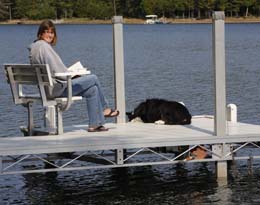Cindy Skadahl - Patient Story
Advanced minimally invasive procedure fixes Skadahl's leaky heart valve
In August 2009, Cindy Skadahl went to the doctor for her annual check-up without any worries about her health. Eight years had passed since she beat breast cancer, and she had recently taken wonderful trips to Germany and Colorado, so Skadahl was feeling pretty good.
During her appointment, however, Skadahl's doctor heard something he didn't like when listening to her heart. A visit to a cardiologist followed, and a diagnosis was confirmed - Skadahl had a condition called Barlow's Syndrome, which prevented her heart's mitral valve from closing properly.
"I didn't even know anything was wrong because I didn't have any symptoms," said the 54-year old Rothschild resident. "I went on the Internet to find out more about it, and based on everything I read, I was expecting it to be something that my doctors would just keep an eye on until it got really bad."
Unfortunately, Skadahl learned that her condition was already quite severe. She would need surgery, and soon, before her leaky mitral valve started to cause structural damage or weaken her heart.
Skadahl visited Aspirus Heart & Vascular Institute surgeon, Ronald Miles, M.D., to discuss her options. Dr. Miles recommended that Skadahl have her mitral valve repaired, rather than replaced. Along with his recommendation, Dr. Miles revealed that he could perform the surgery using a minimally invasive technique, which was music to Skadahl's ears.
"When I first found out I needed surgery I was pretty freaked out because I thought I would have to have my chest cracked open," said Skadahl, who is a Language Arts teacher at D.C. Everest Middle School. "When Dr. Miles told me he didn't have to crack my sternum for the surgery, I thought 'This is so cool.'"
Skadahl underwent minimally invasive mitral valve repair surgery on December 9, 2009, and Dr. Miles was able to perform the entire procedure through a small, 3-inch incision on Skadahl's side. Typically, an 8-inch incision on the sternum is required for traditional mitral valve repair surgeries.
After spending just three days in the hospital, Skadahl went home where she continued to quickly recover. Within a month she was driving a car again and it took just eight weeks for her to return to work full time.
"I expected to be in a lot of pain, but I took a couple Tylenol each day and that was all I needed," she said. "After about seven or eight weeks I could barely tell I had surgery."
Looking back, Skadahl says she probably was experiencing symptoms from her condition because she no longer needs to rest during the day and has a lot more energy than she did before the surgery. She also says that she's impressed that she didn't have to leave the area to have this type of procedure.
"I know a lot of people who have had more invasive heart surgeries and I know how long their recovery was," Skadahl said. "My recovery was so short, and it is pretty amazing that we have this quality of care in our hometown."

Above: Cindy and her husband, Kim, during their trip to Colorado. Below: Cindy enjoys some quiet time while at the family cabin.

New option for mitral valve surgery
The Valve Center of the Aspirus Heart &
Vascular Institute is the only provider in the area to offer minimally invasive surgical options to repair a leaky mitral valve. In undergoing minimally invasive surgery one can expect:
- Shorter stay in the hospital.
- Reduced scarring due to a smaller, more cosmetically discrete incision.
- Faster recovery and return to normal activity more rapdily.
For more information, please call the Valve Center of the Aspirus Heart & Vascular Institute at 877.974.3571.
